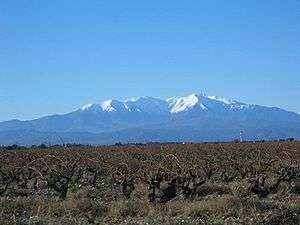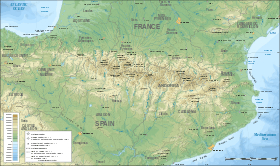Canigou
The Canigó (French: Canigou French pronunciation: [kaniɡu]; Latin: mons Canigosus or Canigonis) is a mountain located in the Pyrenees of southern France.
| Canigou | |
|---|---|
 Canigó, December 2004 | |
| Highest point | |
| Elevation | 2,784 m (9,134 ft) |
| Prominence | 550 m (1,800 ft) |
| Coordinates | 42°31′08″N 02°27′24″E |
| Geography | |
 Canigou | |
| Parent range | Pyrenees |
| Climbing | |
| First ascent | According to tradition, in 1285 by Peter III of Aragon |
| Easiest route | hike |
The Canigou is located less than 50 kilometres (31 mi) from the sea and has an elevation of 2,784.66 metres (9,136.0 ft). Due to its sharp flanks and its dramatic location near the coast, until the 18th century the Canigou was believed to be the highest mountain in the Pyrenees.[1]
Geography
The Canigou is located in Pyrénées-Orientales, south of Prades and north of Prats-de-Mollo-la-Preste. Its summit is a quadripoint between the territories of Casteil, Taurinya, Valmanya and Vernet-les-Bains. Its location makes it visible from the plains of Roussillon and from Conflent in France, and as well from Empordà in Spain.[2]
Twice a year, in early February and at the end of October, with good weather, the Canigou can be seen at sunset from as far as Marseille, 250 km (160 mi) away, by refraction of light. This phenomenon was observed in 1808 by baron Franz Xaver von Zach from the Notre-Dame de la Garde basilica in Marseille.[3] All year long, it can also be seen, with good weather, from Agde, Port-Camargue and the Montagne Noire.
Trekking and sightseeing
Jeep tracks on the north side of the massif lead to the Chalet des Cortalets (at 2150 m) which is a popular outpost with walkers.
There are two ancient monasteries at the foot of the mountain, Martin-du-Canigou and Saint-Michel-de-Cuxa.
Canigou Flame
The mountain has symbolical significance for Catalan people. On its summit stands a cross that is often decorated with the Catalan flag.[4] Every year on 23 June, the night before St. John's day (nit de Sant Joan), there is a ceremony called Flama del Canigó (Canigou Flame), where a fire is lit at the mountaintop. People keep a vigil during the night and take torches lit on the fire in a spectacular torch relay to light bonfires elsewhere.[5] Many bonfires are lit in this way all over the Pyrénées-Orientales, Catalonia, Valencian Community, and Balearic Islands (theoretically), but in practice only goes through the Pyrénées-Orientales and Catalonia.[6]
Literature
The Canigou inspired the epic poem "Canigó" by Catalan poet Jacint Verdaguer i Santaló. In these verses Verdaguer compares the snowy mountain to a Magnolia flower (pages 27–28):
Lo Canigó és una magnòlia immensa |
The Canigó is an immense magnolia |
Sir Humphry Davy's "The Canigou", dated 26 January [1814], was also inspired by a visit to the spot:
- MORNING.
- MORNING.
- In the eastern sky the stars their lustre lose
- In more diffused light, as if their orbs
- Had melted into air, and form'd the day:
- Above, the heavens receive a brighter tint
- Of purest azure; and beneath they glow
- With lovely hues, which every instant change, —
- Now purple and now orange; and a gleam
- Of golden light pours on the tranquil main.
- I cast my eyes upon thy western coast,
- And lo! thy giant form, O Canigou!
- As if a new creation of the day,
- Framed of the morning cloud for ever fix'd,
- And gilded by the expiring morning star.
- So bright thy glittering snows appear, they seem
- To form another dawn: thy base is dark,
- Rising through mists that mingle with the wave!
- In the eastern sky the stars their lustre lose
- NOON.
- NOON.
- The orb of light its flood of lustre pours
- From the mid-heavens upon the tranquil sea
- Without a tide, whose silver mirror spreads,
- Reflecting forms of mountain-majesty
- Along the Iberian coast; and, more remote,
- In gentle agitation feels the breeze,
- That to its deep and lovely azure gives
- The life of motion. All the morning mists
- Have vanished, and the mid-day sunbeams sleep
- Upon thy snows, or glitter where the streams
- They feed with crystal waters pour in foam
- Amidst thy dark deep glens and shaggy woods,
- Where the bright pine and darker cork trees blend:
- Their varied foliage forms a boundary
- Where winter seems to mingle with the spring.
- And lower still, the olive tree appears —
- The work of culture, and the leafless vine,
- And the green meadows, where the torrents sleep,
- Or move obedient to the wants of man.
- Nature in savage wildness — mountain strength, —
- Breathes in one picture with the forms of art,
- And all that stamp the social character.
- A city's walls majestically rise,
- The guardian of a realm whose sounds of war
- Alarm the ear. Along the sandy shore
- The path the Carthaginian trod appears,
- When from the Pyrenees his veterans pour'd,
- To try the strength of Rome, and shed profuse
- Her patriot blood at Cannae. On the wave
- Triumphant ride the fleets of Ocean's Queen.
- My heart throbs quicker, and a healthful glow
- Fills all my bosom. Albion, thee I hail! —
- Mother of heroes! mighty in thy strength!
- Deliverer! from thee the fire proceeds
- Withering the tyrant; not a fire alone
- Of war destructive, but a living light
- Of honour, glory, and security, —
- A light of science, liberty, and peace!
- The orb of light its flood of lustre pours
- EVENING.
- EVENING.
- A moment past the sky was bright and clear,
- But now a mist obscures the ambient air;
- The mist becomes a cloud, which gathers round
- Thy brow; at first so white, — so bright, so pure, —
- The snows seem dark beneath its crisped fringe;
- And now it spreads a thicker canopy,
- And rapidly descends, and fills thy glens,
- And covers all thy rocks. Its tints are changed,
- Its fleecy whiteness gone; the sunbeams fade,
- And lose their glory in its sullen gloom,
- Portentous of the storm! And now the rain
- Descends in floods — the angry lightning gleams,
- The thunder roars; the tempest howls along
- Thy echoing cliffs; and the vexed main
- Mingles her white foam with the troubled floods,
- The torrents from the mountains rolling down!
- A moment past the sky was bright and clear,
See also
- Prieuré de Serrabone
- St-Martin-du-Canigou monastery
- Vernet-les-Bains
Notes
- Histoire du Roussillon - Le relief des Pyrénées-Orientales
- Guide du Roussillon et de l'Andorre : touristique, historique, social, économique, Perpignan, Sud Roussillon, 1968, 286 p.
- Cárdenas, Fabricio (2014). 66 petites histoires du Pays Catalan [66 Little Stories of Catalan Country] (in French). Perpignan: Ultima Necat. ISBN 978-2-36771-006-8. OCLC 893847466.
- Pyrénées Team - Croix du Canigou
- Vermut a la rebuda de la Flama del Canigó
- Festes - l'espai on comença la festa
References
External links
| Wikimedia Commons has media related to Canigou. |
- Canigo.cat All information about the Canigou massif: nature, culture and itineraries (in Catalan)
